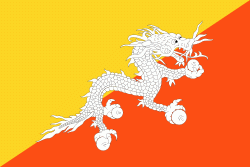Trashiyangtse District (Trashi Yangste)
Trashiyangtse District (བཀྲ་ཤིས་གཡང་རྩེ་རྫོང་ཁག་) is one of the twenty dzongkhags (districts) comprising Bhutan. It was created in 1992 when Trashiyangtse district was split off from Trashigang District. Trashiyangtse covers an area of 1437.9 km2. At an elevation of 1750–1880 m, Trashi yangtse dzongkhag is rich of culture filled with sacred places blessed by Guru Rimpoche and dwelled by Yangtseps, Tshanglas, Bramis from Tawang, Khengpas from Zhemgang and Kurtoeps from Lhuentse.
Trashiyangtse was named by Terton Pema Lingpa during his visit in 15th century meaning; (the fortress of the auspicious fortune).
The northern part of Trashiyangtse encompasses the skills of woodturning and paper making(dzongkha: དལ་ཤོག). Southern part mainly depends on cash crops and animals.
The district seat is Trashiyangtse.
Three major languages are spoken in Trashiyangtse. In the north, including Bumdeling inhabitants speak Dzala. In the south, Tshangla (Sharchopkha), the lingua franca of eastern Bhutan, is spoken in Jamkhar, Khamdang, Yalang and Ramjar Gewogs. In Tomzhangtshen Gewog, residents speak Chocha Ngacha and khengkha.
Trashiyangtse was named by Terton Pema Lingpa during his visit in 15th century meaning; (the fortress of the auspicious fortune).
The northern part of Trashiyangtse encompasses the skills of woodturning and paper making(dzongkha: དལ་ཤོག). Southern part mainly depends on cash crops and animals.
The district seat is Trashiyangtse.
Three major languages are spoken in Trashiyangtse. In the north, including Bumdeling inhabitants speak Dzala. In the south, Tshangla (Sharchopkha), the lingua franca of eastern Bhutan, is spoken in Jamkhar, Khamdang, Yalang and Ramjar Gewogs. In Tomzhangtshen Gewog, residents speak Chocha Ngacha and khengkha.
Map - Trashiyangtse District (Trashi Yangste)
Map
Country - Bhutan
 |
 |
| Flag of Bhutan | |
The subalpine Himalayan mountains in the north rise from the country's lush subtropical plains in the south. In the Bhutanese Himalayas, there are peaks higher than 7000 m above sea level. Gangkhar Puensum is Bhutan's highest peak and is the highest unclimbed mountain in the world. The wildlife of Bhutan is notable for its diversity, including the Himalayan takin and golden langur. The capital and largest city is Thimphu, holding close to 1/7th of the population.
Currency / Language
| ISO | Currency | Symbol | Significant figures |
|---|---|---|---|
| BTN | Bhutanese ngultrum | Nu | 2 |
| INR | Indian rupee | ₹ | 2 |
| ISO | Language |
|---|---|
| DZ | Dzongkha language |















